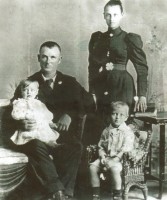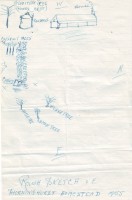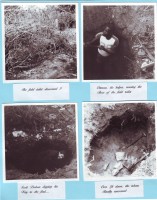 Ref: EG&T X
Tokens of S Africa and their
History - Dr G P
Theron ,
Item 326
listed on page 130
Brian
Hern's
catalogue of Southern
African tokens (2004), and
unlisted
in
Maynard's book on S African
tokens
Ref: EG&T X
Tokens of S Africa and their
History - Dr G P
Theron ,
Item 326
listed on page 130
Brian
Hern's
catalogue of Southern
African tokens (2004), and
unlisted
in
Maynard's book on S African
tokens
-
Scott Balson's talk on the F C Larkan tokens given to the Pietermaritzburg Numismatic Society - 1977
-
Togt labour "bobbin" trade tokens issued by Percival Larkan 1940-1955

-
Letter received from Robert Percival Larkan: page one, page two.
-
Digging up the dunny/field toilet/closet and uncovering "dual purpose" corroded F C Larkan tokens
-
F C Larkan mintages - still existing - counted by Balson in 1978
-
Allyn Jacob's poem on the Larkan (October 2006)
-
Audit of F C Larkan tokens in Balson Holdings Family Trust April 2005
-
From Ox-Wagon to Motor Car in East Griqualand by Percy Larkan
Scott Balson's talk on the F C Larkan tokens given to the Pietermaritzburg Numismatic Society in October 1977.
Mr Chairman, ladies and gentlemen, before starting my talk, I would like
to read to you an extract from a letter Dr Theron wrote to me on the 27th
September 1977. (Dr Theron was South Africa's foremost token coin collector
and has written a book on South African
tokens).
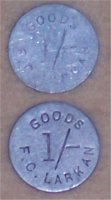
"Even I find it difficult to admire a thin triangular piece of galvanized zinc in the form of a Transvaal token, after I have looked at an uncirculated Kruger Pond or Crown".
This is probably the only point on which I disagree with Dr Theron, as every type of token has its own personal history, divorced from all other tokens. Furthermore, 99% of all tokens are unresearched, awaiting the eager numismatists attention - unlike South African coinage. This, coupled with the hours of research to get one vital contact, makes token coin collecting such a rewarding hobby. Take the tokens of Mrs Frances Charlotte Larkan for example.
Image right: The only F C Larkan token struck (in error) on both sides.
Mrs Larkan's tokens have more than a numismatic interest to me. My whole involvement with these tokens has been a most rewarding experience, as I was destined to play a part in their history. The part which I played is something which a numismatist dreams of, but is rarely, if ever, fortunate enough to savour.
Image right: John Robert William Larkan, John Robert Larkan's Scottish father
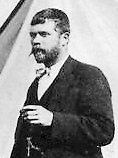 Members may recall my talk on the tokens of Strachan and Co in April 1977.
During my research into these tokens I came across a handful of tokens previously
unknown to numismatists. I discovered them in a small canvas pouch in a small
metal canister full of Strachan and Co trade tokens. (In 1929 - 1930 Strachan
and Co bought the failing stores from Mrs F C Larkan - the reason why they
had this small stock with their trade tokens.)
Members may recall my talk on the tokens of Strachan and Co in April 1977.
During my research into these tokens I came across a handful of tokens previously
unknown to numismatists. I discovered them in a small canvas pouch in a small
metal canister full of Strachan and Co trade tokens. (In 1929 - 1930 Strachan
and Co bought the failing stores from Mrs F C Larkan - the reason why they
had this small stock with their trade tokens.)
In July 1977 Dr Theron wrote to me,
"This letter is just to say that the set of Larkan tokens arrived safely. What a thrill for me receive a set of four tokens just about unknown so far, in quite nice condition. This is the thing about collecting tokens. When dealing with coins there are several catalogues to tell you all about them, mint figures, the lot, but with tokens you never know. I was asked about these Larkan tokens about 2-3 years ago by Stan Kaplan, but at that stage I could just say nothing."
Prompted by this remark by a token coin collector of such renowned standing I decided that the Larkan tokens required a lot more research than I had already undertaken.
I wrote a handful of letters to all the Larkans in Natal. Two letters bore fruit. Mr and Mrs Terence Larkan of Harding and Mr Robert Percival (known as Percy) Larkan of Durban. Mr Percy Larkan of Durban, an elderly man, very kindly invited me to visit him when I was next in Durban. This I did. The story he told me was as fascinating as it was complex.
Image right: John Robert William Larkan, Anne Margaret Wallace and their sons, Edward Wallace (on chair) and John Robert.
In 1872 two brothers John Robert William Larkan and George Larkan sailed from Kilkenny, Eire, with their families to East London. In 1875 they trekked north into the heart of Nomansland (between the colonies of the Cape to the south and Natal to the north). In about 1880 they formed a partnership and bought the farms of Antioch and Raven Hill in the Nqabeni district near Harding.
Soon after they bought Bont Rand (named after a speckled cliff above the farm), outbidding a syndicate of Donald Strachan and Stafford at an auction held in a hotel room in Kokstad. John Larkan paying about six hundred and forty pounds sterling. The farm was 3,200 acres in extent - costing four shillings an acre.
In 1890 John Robert William Larkan's son, John Robert Larkan, born in 1870, set out on his own. In Durban he was contracted to build the railway line between Durban and Stanger. During the building of this line he formed a strong friendship with an associate, Mr Baytoppe. It was through this friendship that he met Mr Baytoppe's daughter, Frances Charlotte Baytoppe, who later became his wife.
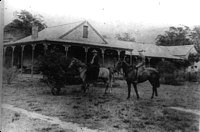 After
building the railway line between Durban and Stanger, he assisted in the
building of the railway line between Glencoe and Dundee. With the money he
had earned through his work he was able to buy Bont Rand from his father
and his uncle. Such was the price of land he was able to buy two other farms,
Readsdale and Gaybrooke. In 1894 he married Francis Charlotte Baytoppe and
they settled on the farm Bont Rand.
After
building the railway line between Durban and Stanger, he assisted in the
building of the railway line between Glencoe and Dundee. With the money he
had earned through his work he was able to buy Bont Rand from his father
and his uncle. Such was the price of land he was able to buy two other farms,
Readsdale and Gaybrooke. In 1894 he married Francis Charlotte Baytoppe and
they settled on the farm Bont Rand.
Image right: Mrs F C Larkan and William John Baytoppe (Mrs F C Larkan's brother on the horse Saamloop) outside the Bont Rand farmhouse circa 1908)
A rather strange custom in force during those early days was the practise known as "halving". This was the letting of land to the locals, whose rent was half the crops that they reaped. John Robert Larkan would gather his share of the crops and sell them in areas of famine for skins, hides, and other goods which he would then sell in Durban for a profit.
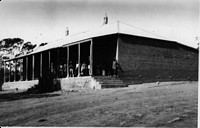 After a while he found this exercise rather tiring so he
decided to open a store on the farm at Bont Rand where natives from areas
of famine could conduct their barter trade. He did this in 1901, the year
he bought a small tract of land 100 acres in extent, called Cupar, from a
Scotsman Jack Bonnar. (Cupar is named after a small town in Scotland). John
Larkan opened a store at Cupar too, which was run by a man called Ernest
Buhre. (The natives called the Cupar store "Kwabuwe" after him, a name which
still sticks today, in the store now owned by Strachan and Co.
After a while he found this exercise rather tiring so he
decided to open a store on the farm at Bont Rand where natives from areas
of famine could conduct their barter trade. He did this in 1901, the year
he bought a small tract of land 100 acres in extent, called Cupar, from a
Scotsman Jack Bonnar. (Cupar is named after a small town in Scotland). John
Larkan opened a store at Cupar too, which was run by a man called Ernest
Buhre. (The natives called the Cupar store "Kwabuwe" after him, a name which
still sticks today, in the store now owned by Strachan and Co.
Image right: The Bont Rand store rebuilt in the 1920s.
Barter trade John Larkan found was a totally unsatisfactory way to conduct business. He had seen how the Strachan and Co trade tokens had been used as general currency in the region to the benefit of the Strachan stores and decided to create his own out of cardboard with a monetary value written in ink. The denominations were 5, 4, 3, 2, and 1 shilling and nine, six and three pence. This form of coinage was readily accepted by the natives who could redeem them for goods at the Larkan stores as they required them. Mr Percival Larkan recalled them very clearly and made me a set of replica cardboard Larkan tokens out of an old Kelloggs packet.
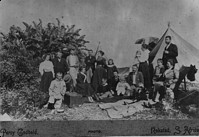 Image right: This photo taken
in 1901 near the beach in Pondoland shows
Image right: This photo taken
in 1901 near the beach in Pondoland shows
L-R standing: Evangeline Larkan (John Larkan's sister); Edward Wallace
Larkan (John Larkan's brother); Charles Hutchinson; Frederick A Larkan (John
Larkan's brother); Dolly Hutchinson; (nee Larkan); Ruby Hutchinson; Rosalie
Larkan (John Larkan's sister); Evelyn Hutchinson; Frank Larkan (R P Larkan's
brother) and John Robert Larkan.
L-R Seated: William Dowling Larkan; Granny Larkan (John Larkan's mother;
Pip Hutchinson; George Larkan jnr (John Larkan's brother); Bunny Hutchinson;
Philip Hutchinson; Taffy Larkan (John Larkan's brother); Frances Charlotte
Larkan and Robert Percival Larkan (back to camera)
On the 26th September 1906 Mr John Robert Larkan died at the age of 36. Mrs
Frances Charlotte Larkan was in a desperate position, being burdened with
her young children in the middle of nowhere. She called in the assistance
of her brothers William and Arthur Baytoppe. One of the first things that
the brothers did was renovate the old store at Bont Rand as thieves had merely
dug their way through the mud walls to steal goods at night.
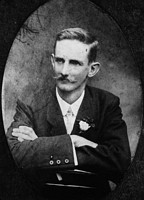
Image right: William John Baytoppe who came to his sister, Mrs F C Larkan's aid but knew nothing about running stores in isolated areas - leading to his sister's bankruptcy after her husband died.
William Baytoppe had all the cardboard tokens burnt as the natives had started to alter the figures represented on them - their favourite alteration being the three shilling to a five shilling. Two shillings in those times represented the equivalent of 40 pounds of shelled mealies (maize). William Baytoppe had seen many of the brass Strachan and Co tokens and they had even accepted them at their stores. He suggested to Frances that she have coins made on a similar line. She ordered aluminium tokens from a firm in Durban to replace the cardboard tokens. These tokens were issued through a genuine shortage of currency as their stores were several days distance by horse from the towns and cities in Natal. Location of Larkan's stores can be seen at this link.
Uncorroded tokens (non-closet) extremely Rare (Fuld) Rarity Scale: R -7)
Used from 1906 - 1929 at F C Larkan stores.

There are known to be 19 uncorroded sets of the four F C Larkan tokens
in the world.
-
the Killie Campbell Library in Durban (ex Dr C Graham - ex Balson)

-
Rege Padraza (USA) (ex Balson)
-
Eddie Sherwood (Pietermaritzburg) (ex Balson)
-
Allyn Jacobs (ex Martin Badenhorst collection - ex Balson) and
-
Dr G P Theron's collection (ex Balson).
Most of the F C Larkan 2/- trade tokens were manually holed as seen on right
Engraved tokens extreme rarity (Fuld) Rarity Scale: R - 8 to R - 10):
The minting was of four denominations: the florin, shilling, sixpence and tickey (3d). According to Percival Larkan about 2,000 tokens were minted (about one third remain). The natives were quick to give them the name "amakence" (after the Strachan and Co "kence"). The aluminium tokens are uniface bearing the details "Goods" and "F C Larkan" in the surround with the value in the center. Five type sets are known to have been modified from the original machine engraved tokens. Each type is represented by a symbol hand engraved with a sharp instrument into the blank back of the tokens. According to Percival Larkan the blank token with no engraving on the back, the commonest, originated from the Bont Rand store.
All the engraved pieces representing other stores are extremely rare including:
-
a "Circle" engraved on the back originated from the Cupar store;
-
a "Cross" engraved on the back representing stores leased from Stafford from time to time;
-
a "C" engraved on the back originated from the Cancele store; and
-
a "Triangle" engraved on the back of the Pikinin Store (native name Sihleza).
Pikinini and Cancele Stores were opened by Mr John Reed for Mrs Larkan in 1925 when the business was in financial trouble.
(Audit of store sets at this link)
Click on image below for larger image of trade tokens used only
between 1907 - 1929

 |
 |
|
|
Mr Reed took over the running of Mrs Larkan's business from the Baytoppe brothers in 1910. Unfortunately he was no businessman and lost the Larkan family fortune. His move in opening the Cancele and Pikinini stores when Mrs Larkan's business was already in financial distress was the last straw - he was sent packing.
The stores never recovered so in 1929 Mrs Larkan was forced to sell her doomed enterprise for a song to Donald Strachan's son, Douglas. She sold all four stores, Bont Rand, Cupar, Cancele, and Pikinini. The F C Larkan tokens found by Scott Balson in the small canvas pouch among the Strachan and Co tokens when cataloguing the Strachan and Co stock were those only used for trading purposes being handed in to the Larkan stores by natives after the sale of the business.
At this point Mr Percival Larkan, Mrs Frances Charlotte Larkan's son, took control of the destiny of the bulk of the tokens so who better to relate the story as he does in his letter below:
Dear Mr Balson
Further to your most interesting visit on the 8th September 1977 relative to the F C Larkan tokens.
As promised I will endeavour to relate further "Token Tales" of these once very useful pieces of "Trading Coins".
In 1929 my mother, Mrs F. C. Larkan sold the trading stores of Bont Rand, Cupar, Cancele, and Sihleza (Pikinini) to Messrs Strachan and Co of Umzimkulu.
As Messrs Strachan and Co were obviously not interested in these tokens, I took possession of them in case they would be useful later. Mrs Larkan sold the farm Bont Rand to the native trust in 1936, when I vacated the farm and took possession of the farm "Protea" in the Glengarry area of the Umzimkulu district. About 1938 to 1939 the Native Trust and Land Act bought up all the farms in the Glengarry area and we* had to find pastures anew. Fortunately was able, with the help of the Department of Lands, to obtain possession of a portion of the farm "Thorninghurst" which is situated about six miles from Donnybrook in Natal. (*Percival Larkan married N F Larkan while at Protea)
In November 1939 we packed our bags, tokens included, left "Protea" and sallied forth to "Thorninghurst".
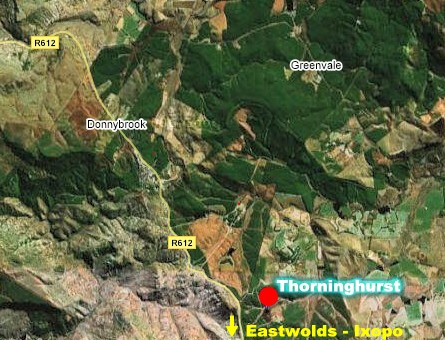
(Location
of Thorninghurst on this
aerial map of extended area)
After having settled down on the farm. And being adjacent to number four Native Location, I found that ample casual labour (Togt) mostly ntombazans were available and would be ideal labour for light duties such as hay making, reaping mealies, silage making, lifting potatoes, turnips etc.
The problem now arose, as in my father's case, when he started trading what to do about petty cash. The nearest bank was 20 miles away. Then the token idea came back to mind. Armed with a few of the tokens in a tobacco bag I called on Mr Laurie Pennefather, Miller and Trader at Eastwolds, only two miles away and asked him if he would kindly co-operate with me and accept the tokens as petty cash and I would repay at the end of the month when I paid my account. To my joy Pennefather accepted.
Next day when I took the milk to Nestle's Factory at Donnybrook, I called on Messrs Frangs Bros and later Mr Dawood Asmall (both traders) in Donnybrook. Both firms were very willing to help me in this problem. My delight knew no bounds. (Thorninghurst was about 2 kilometres from both Donnybrook and Eastwolds)
For 16 years the F. C. Larkan Trading Tokens took on a new trend of usefulness during their lifespan ending with farming and trading.
In 1955 I sold "Thorninghurst" to my neighbour Mr Eric Cairns and before leaving I took the bag of tokens and deposited them in the wood and iron closet which was situated alongside a St Johns creeper below some chestnut trees on the south side of the house.
Had I realized that there was a "hereafter" or some sort of attachment of importance later to these F. C. Larkan tokens, I would not have allowed them to befall the fate they did, particularly that they co-ordinated a unique unity of purpose and endeavour between farming and trading. Enclosing a rough sketch of the old homestead, hope you will find it interesting.
Yours faithfully, R P Larkan
 |
 |
 |
 |
On the road to Thorninghurst |
The Donnybrook Hotel |
Chele behind the Donnybrook bar |
Amazing views near Donnybrook |
Extracts from Robert Percival Larkan's obituary: Born at Bont Rand on the Ibisi River between Umzimkulu and Harding. Saw service in South West Africa and German East Africa during the First World War. Married Natalie Florence Jones on 27th May 1920 - had two sons and two daughters. Supplied fresh milk from his farm Thorninghurst in the Donnybrook District to the local condensed milk factory and local shops from 1939 - 1955 (where his trade tokens were exchanged). Sold his farm to Cairns and moved to Durban. After meeting Scott Balson in 1978 he compiled a history of the Larkan family, farms, stores and people at East Griqualand. His unpublished book was to be called "From Ox-Wagon to Motor Car in East Griqualand". |
Digging up the dunny/field toilet/closet - Very Rare (Fuld) Rarity Scale: R - 5 to R - 7):
On the 14th September 1977 I obtained the permission of Mr Mervyn Cairns, son of Eric Cairns, to dig and explore as I pleased on his farm "Thorninghurst" in the Donnybrook area. I explained that I was looking for token coins which had been buried in an old long drop for over 22 years. I think that he thought that I was quite mad and who could blame him - but I promised to give him a set of the tokens if I found them!
Image right: the sketch map drawn by Percy Larkan
On Saturday 17th September 1977 I drove out early in the morning to the farm armed with a borrowed spade, Percival Larkan's rough sketch map and a camera. The track off the main road to Donnybrook going down to the old farmstead was steep and rough. I pulled up alongside the old stone shed that was built by Mr Larkan in 1940. It was with dismay that I saw that the remains of the old farmhouse was now overgrown with thick bush and grass. (It was destroyed in 1965 after the Cairns moved to live on their new farm near Ixopo). The walls of the old rondavel still stood and this together with the ruins was all I had to work with when trying to work out my bearings from the rough sketch map.
You can imagine my great joy when trying to work out for the fiftieth time in my mind where it should be when I saw the unmistakable "hollow" of an old closet in the ground. It was now filled with soft earth and under a thick cover of old leaves guarded above by the unruly St Johns creeper that Percival Larkan had spoken about in his letter. I made short work of the creepers cutting a path to the hollow.
I cleared the immediate area and set about digging. By ten o'clock I had dug to a depth of about four feet and come across the first unmistakable signs of an old toilet.
Image right: Photos taken during the dig
I placed a handkerchief across my nose and mouth and started moving items like plastic bags dated 1947 and old bottles from the hole. By noon I was six feet down and feeling rather exhausted as I had been digging non-stop since 9am. I sat down for a rest on the floor of the toilet feeling rather despondent as I had found just about everything but the F C Larkan tokens. Sitting there I absent-mindedly sifted a patch of dried human excrement through my hands and saw an amakence - a token. I don't think that I have ever moved so fast or found such reserves of energy so quickly.
By 1 o'clock I had recovered about 200 tokens. They were all corroded - most badly even to the point of being holed and fragmented but a few had survived the onslaught of human excreta with just the slightest surface corrosion - but all were corroded to the point of identification from the small cache found while studying the Strachan and Co tokens held in safekeeping at the Strachan store at Umzimkulu. Most were not worth keeping.
Among the tokens were a number of previously unknown aluminium "bobbin" shaped tokens bearing the initials of Robert Percival Larkan and his wife Naomi Francis Larkan (RPL and NFL).
Half an hour later it started to rain. I was happy that I had found all the
tokens in the pit so filled it as the soft rain fell around me. The problem
now facing me was getting off the farm as my Mini Minor could not make it
back up the bad track which had now turned to a river of mud. Luckily an
African with a tractor was at hand - a bribe of a beer did the trick.
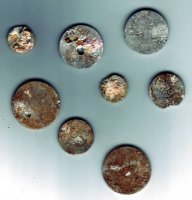
By late that afternoon I was in Pietermaritzburg with Prof Clive Graham, a well known numismatist and expert in physics, cleaning the tokens in an acid bath to prevent further corrosion. The "frozen" corrosion on the aluminium "closet" tokens serves an important purpose - it distinguishes the token that were only used between 1907 to 1929 from those that were again put to use in 1940 and used by Percival Larkan up to 1955. The corrosion has been "frozen" through the acid treatment and the F C Larkan tokens dug up in 1977 in the Balson Holdings Family Trust remain today as the day they were cleaned in the acid bath.
Image right: sample of corroded F C Larkan tokens found in the old toilet
I posted Mr Mervyn Cairns a set of the F C Larkan tokens that I had I dug up the following week - I still wonder what he did with them.
As I have seen the only Larkan tokens still in existence I believe that I can supply accurate figures on the numbers of F C Larkan tokens which remain.
A set of the corroded F C Larkan tokens was provided to Allyn Jacobs in exchange for other tokens from Nomansland. This is the only set privately owned outside the Balson Holdings Family Trust collection.
The tokens found in the closet (still in their original Barclays National Bank coin bags after cleaning):
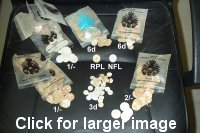
F C Larkan mintages - still existing - counted by Balson
in 1978
3d trading only |
6d trading only |
1/- trading only |
2/- trading only |
20 |
21 |
22 |
19 |
NOTE: less than |
ten of the tokens counted |
in the rows below have been | released to the public. |
3d trade and farm |
6d trade and farm |
1/- trade and farm |
2/- trade and farm |
213 in closet |
413 in closet |
520 in closet |
326 in closet |
Original mint: 450 |
Original mint: 550 |
Original mint: 600 |
Original mint: 400 |
*Identifiable coins after digging reflected "in closet" ie larger number of each dual-purpose denomination. Those coins that were too badly corroded were later returned after counting and then reburied in the closet leaving the only pieces saved being those that were "not too bad". The smaller denominations like the 3d were largely destroyed by corrosion in the closet and could not be individually identified.
Trading only tokens: 82 pieces. Dual purpose tokens identified:
1472 pieces (note several hundred pieces were corroded beyond recognition).
Total counted: 1,554. Total original mintage of F C Larkan pieces:
2,000 pieces
Complete sets of the four "dual purpose" tokens also held by:
- Allyn Jacobs (South Africa)
- Mark Radley (Australia)
- Steve van Niekerk (South Africa)
Dung-besmattered though they be,
The Larkans are a joy to see!
Staffords with their backsides etched,
Reek of mielies that were retched....
Long years they mouldered in latrine,
And but for you were never seen!
Allyn Jacobs - October 2006
RPL and NFL "Bobbin" togt (Day Labour) tokens extremely
Rare (Fuld) Rarity Scale: R 6 -7):
On top of this extremely valuable find, as mentioned earlier, I found a new previously unknown token in two forms. One bore the initials RPL (Robert Percival Larkan) and the other NFL (Naomi Frances Larkan) - Percival's wife's initials. These tokens are also struck in aluminium but differ from normal tokens in that they closely resemble a bobbin. Each bobbin has its own unique number. The RPL tokens are numbered 1 to 64 while the NFL tokens are numbered 1 to 36 (ie allowance of up to 70 *togt labour for Percival and 40 *togt for his wife). As with the F C Larkan tokens many of the bobbins were corroded beyond recognition. I have 27 of the NFL tokens and 55 of the RPL tokens. The balance were too badly corroded. (Audit at this link)
Mr Percival Larkan told me later that these bobbins were identification discs for the *togt labour used by he and his wife as day labour tokens - by presenting the bobbin to the Larkan's the togt labour confirmed their identity. On presenting the day labour token the togt labour were rewarded with F C Larkan tokens that they could take to Dawood Asmall, Frangs or Laurie Pennefather to purchase goods at those stores located nearby. This practice continued until 1955.
*Togt labour: farmers often employed young boys from eight years of age on a casual basis to help in tasks such as milking cows, herding cattle, etc. This practice was refered to as "togt labour".
| Hi Scott
Some years back I made contact with F.C Larkan's daughter in Durban. I spent the whole of half a day with her chatting. I recorded some of the things she said on tape. She gave me some of the most interesting items that were taken from the stores and that were used by F.C Larkan. I have the original Ledger with daily takings written in F.C Larkan's hand writing from the Bont Rand store. She also gave me a bottle of beads taken from the shop and still in its original bottle that was sold in the shop. The most interesting item was a Victorian scissors that was used by F.C Larkan for sowing. In the ledger starting from the back, are all Larkan's recipes. I will never forget the day when she pulled out a box, and it were Larkan tokens including some of the bobbins...... Some days later, she got me in contact with her brother. He showed me the original Boer war medals of Larkan himself. He was kind enough to give me a printout of the Larkan family tree. Apparently, they still have family reunions at Donnybrook one a year. I have since lost contact with them as they have moved. In the past few years, a lot of items from Strachan and Larkan have been coming out of the woodwork. I have a dispensing machine for matches which I purchased at the Cannons auction with +- 35 Strachan tokens still in it. Personally, I think there is still a lot of stuff out there and not all were accounted for. best regards Anthony Govender (Durban) |
Audit of F C Larkan tokens in Balson Holdings
Family Trust Ten (10) complete Bontrand "trading only" Sets complete:
(Tokens in one of the complete "trading only" sets referred to earlier carried symbols and have been allocated to the other store sets below:)
Trading store token sets (not Bontrand) -
|
Note all photos on this page are original and owned by the Balson Holdings
Family Trust.


